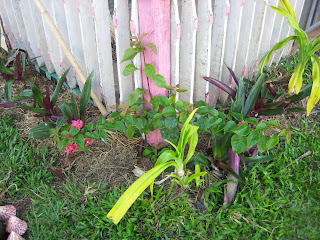When I left for the Peace Corps, I had three personal goals (in addition to helping the community). #1 was to learn a new language. #2 was to learn to cook. #3 was to learn how to garden.
I am very proud of the gardening skills I have developed. Here are some pictures of what my teitei looks like so far.
(August 2010)
This is by far the most self-indulgent article I've ever posted on this blog before. I realize that most of you probably don't care to see the minute changes in plant growth taking place on my compound, but I am utterly fascinated by what is taking place before my eyes. It is so cool to plant something, watch it grow, see it flower, and finally eat its fruit! So, I've posted the most recent pictures of my garden and flowers (that I spend at least 30 minutes watering every single morning and at least a few hours a week weeding and tending to). These plants are one of my proudest accomplishments so far in Fiji.
So, enjoy.
:-)
*************************************************

Noqu Kompound: Before. (March)

Noqu Kompound: After. (June)

Noqu Kompound. (August 2010)
Bougainvillea Flowers. Planting along my front veranda railing and against my bathroom wall. They just started flowering! (August 2010)



Pumpkin. (August 2010)



There is also a watermelon plot to the left of the Squash, but at the time this picture was taken, the buds were too young to be remarkable.

Zucchini. (August 2010)

One of S.K.'s kittens, Meleni. (translation: "Melon". I like to think that this name, given by her new owners, was at least partially inspired by the name of my cat back home in San Diego, California, whose name is Mango.)

My Compost.
********************************************************************

The side yard: Before. (March 2010)

The side yard: After. (May 2010)
The Side Yard. (August 2010)

Dhanya and Cilantro. (May 2010)

Rokete: Lailai/Levu (Hot Chili Peppers: Small/Large), Tomole (Basil). (May 2010)

Basil. (August 2010)


Rokete (Hot Chili Peppers). (August 2010)

Baigani (Eggplant), Cobona (Lemongrass). (May 2010)

Kareti (Carrots), Kiukaba (Cucumber). (May 2010)


Baigani (Eggplant), Cobona (Lemongrass). (May 2010)

Kareti (Carrots), Kiukaba (Cucumber). (May 2010)

Cucumber. (August 2010)

The back yard. (March 2010)

The back yard. (April 2010).

The back yard. (June 2010)
The main garden consists of: Tomata (Tomatoe), French Beans, Butter Beans, Capsicum (Bell Peppers), Kaveti (Cabbage), Letisi (Lettuce), Broccoli, and Cauliflour.
**********************************************************************

The back yard. (March 2010)

The back yard. (April 2010).

The back yard. (June 2010)
The main garden consists of: Tomata (Tomatoe), French Beans, Butter Beans, Capsicum (Bell Peppers), Kaveti (Cabbage), Letisi (Lettuce), Broccoli, and Cauliflour.

The Backyard Garden. (August 2010)

Tomatoes in the Back Garden. (August 2010)
New Backyard Garden. Watermelon, Round Cabbage, Carrots, Long Beans, French Beans, Corn, Eggplant, Avocado Tree, and Papaya Tree. (August 2010)

Fijian Cilantro. (August 2010)

Nursery for future planting. (August 2010)
******************************************************
(August 2010)
Another reason that gardening has been one of my most satisfying tasks thus far in Fiji has to do with the transformation that has taken place around me in the village, simply as a second-degree result of my efforts... Almost every single house has started a vegetable garden of their own!!
This is not a culture that prides itself on growing perishable vegetables close to home. Instead, Fijians hike into the jungle and plant enormous "fields" of root crops. After 4-6 months of no work (weeding the "farm" once), they harvest the roots, which can last up to 6 weeks before being cooked. Furthermore, while the crops are growing underground, the leaves can be picked, boiled in hot water, and eaten with Coconut milk (squeezed coconut shavings mixed with hot water). This is the staple of the Fijian diet... at least in my village. It is sometimes supplemented by fresh fish.
Unfortunately, there is some racism in Fiji between the ethnic Fijian population, and the approximately 30% Indo-Fijian population that is mostly concentrated in town areas. Traditionally, vegetable garden is associated with Indo-Fijian culture, and that is another reason that Ethnic Fijians often resist starting home gardens.
However, when I began my own garden--by planting simple, Fijian, crops like Bele (a leaf that can be boiled and eaten like Spinach), Pumpkin, and Eggplant--many people in my village began to grow jealous. So, we started sharing seeds, and planting tips. Luckily, around the time that everyone was starting up these staple crops, the "hurricane relief" fund kicked in and cabbage, bean, and cucumber seeds were distributed to villages all across my island. As you can imagine, the gardening extravaganza blew up from there. Now, I am proud to say that most of the women are getting out of their houses more and contributing to their families in a traditionally-male way (by providing food). The teachers at the local elementary school have remarked that the kids from my village have started bringing noticeably healthier lunches to school, and all the village families have started to eat more balanced diets (getting a far greater variety of nutrients than before).
In the Peace Corps, this is what we refer to as a secondary project. I am VERY proud of mine.

Emi in her Cabbage Patch. (August 2010)

Ili and Jo's Tomatoes and Long-Beans. (August 2010)

Lydia's Eggplant, Bean, and Herb garden. (August 2010)

Sotia's Corn Patch. (August 2010)

Mesi and Tevita's Cabbage and Cucumber Nursery. (August 2010)
That's all for now.
Vinaka Vakalevu for visiting my blog.
xx
Milika











OMG, your garden is incredible, and how wonderful to be such a positive infuence on your village forever! I am very proud of you. MOM
ReplyDeletewhat an amazing blog very inspiring.....
ReplyDelete